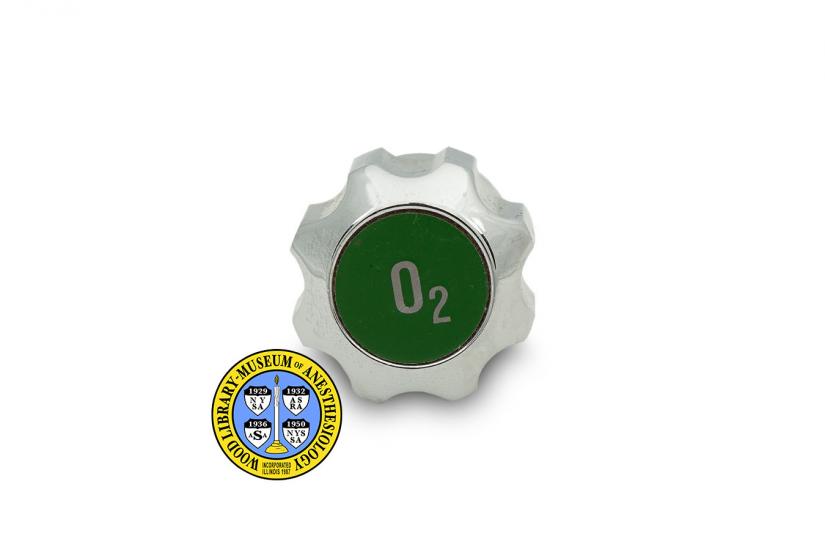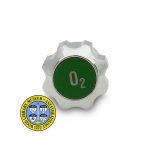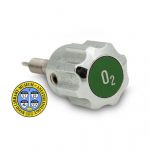Calverley Oxygen Knob
Since the 1890s, anesthesia machines have included oxygen along with anesthetics. When resuscitation is needed, the anesthetic is stopped while the oxygen continues to flow. The flow of each gas through the machine is controlled manually by a knob, and is registered on an upright flowmeter. On a single machine, the knobs and the flowmeters for each gas are arranged from left to right in the same order. But that order varies from one machine to another.
Until 1971, these knobs could only be told apart by looking at them. In that year, Dr. Roderick K. Calverley (1938-1995) introduced a new oxygen knob design that could be easily recognized by touch alone. This reduced the possibility of error, and allowed anesthesiologists to manipulate the oxygen knob without having to take their attention away from the patient during resuscitation. The new knob could be fitted to any machine inexpensively. The simplicity of this safety feature helped to make it a standard by 1978.
Dr. Calverley was a scholar of the history of military medicine, and the history of anesthesia. Since 1987, the Wood Library-Museum has offered research fellowships named in Dr. Calverley's honor.
Catalog Record: Calverley Oxygen Knob
Access Key: akwp
Accession No.: 1991-08-09-1 B
Title: [Calverley oxygen knob.]
Title variation: Alt Title
Title: Oxygen flow knob.
Title variation: Alt Title
Title: Fluted oxygen flow control knob.
Publisher: [Madison, Wisconsin?] : [Ohio Medical Products?], [1971-1990].
Physical Descript: One knob : metals, plastic ; 2.4 in diameter) x 6 in depth cm.
Subject: Equipment Safety – methods.
Subject: Oxygen – instrumentation.
Note Type: General
Notes: The title is based on the WLM common name for the object.
Note Type: General
Notes: The early year in the date range for the possible year of manufacture is
based on the year that Dr. Roderick Calverley suggested in a published
article that oxygen flow knobs on anesthesia machines should be
distinguishable from other gas flow knobs by touch alone (1971). The end date
is a generous estimate based on a maximum useful life of the machine from
which the knob was taken, for the purposes of photographing.
Note Type: With
Notes: This knob was removed from the Ohio Heidbrink Kinet-O-Meter Compact Model,
accession number 1991-08-09-1 B, photographed and placed back on the machine.
Note Type: Citation
Notes: Calmes SH. In memorium: Dr. Rod Calverley, 1938-1995. Paper presented at:
American Society of Anesthesiologists 1995 Annual Meeting; Atlanta, Georgia;
October 24, 1995.
Note Type: Citation
Notes: Calverley RK. A safety feature for anaesthetic machines: touch identification
of oxygen flow control. Can Anaesth Soc J. March, 1971;18(2):225-229.
Note Type: Citation
Notes: Dorsch JA, Dorsch SE. Anesthesia machines and breathing systems: an
evolutionary success story. In: Eger EI, Saidman LJ, Westhorp RN, eds. The
Wondrous Story of Anesthesia. New York, NY: Springer; 2014:712.
Note Type: Citation
Notes: Jacob AK, Kropp SL, Bacon DR, Smith KM. The history of anesthesia. In: Barash
PG, Cullen BF, Stoelting RK, Cahalan MK, Stock MC, Ortega R, eds. Clinical
Anesthesia. 7th ed. Philadelphia: Wolters Kluwer/Lippincott Williams &
Wilkins; 2013:13.
Note Type: Citation
Notes: Rendell-Baker L. Some gas machine hazards and thier elimination. Anesth Analg
1976;55(1):26-33. https://journals.lww.
com/anesthesia-analgesia/pages/articleviewer.
aspx?year=1976&issue=01000&article=00006&type=abstract. Accessed August 3,
2014.
Note Type: Citation
Notes: Roderick K. Calverley Humanitarian Service Award. UC San Diego Division of
Medical Education website. https://meded.ucsd.
edu/assets/61/File/calverly_nomination.pdf. Accessed August 3, 2014.
Note Type: Citation
Notes: Roderick Kerns Calverley, M.D. (1938-1995). Bull Anesth Hist. July,
1995;13(3):3. https://ahahq.org/Bulletin/July%201995,%20Vol%2013%20%283%29.pdf
Accessed August 3, 2014.
Note Type: Physical Description
Notes: One oxygen flow control knob from a Ohio Heidbrink Kinet-O-Meter Compact
Model anesthesia machine; Made of metal except for face which may be a
plastic disc. The face of the plastic disc acts as a label for the knob; It
is green with silver lettering, “O” and a subscripted number “2”; The knob is
fluted with eight grooves; A narrow pin extends from the back of the knob
approximately 3.5 cm; Part of the pin is threaded and then it tapers to a
point approximately 1 mm in diameter; Except for the ‘O2’ there are no other
markings on the knob.
Note Type: Reproduction
Notes: Photographed by Mr. Steve Donisch, September 18, 2013.
Note Type: Historical
Notes: The oxygen (O2) flow control knob on anesthesia machines is shaped so that
the anesthesiologist can identify it by touch alone. This helps to prevent
inaccurate gas selection, especially when working with an unfamiliar
anesthesia machine, or during an emergency when a physician is attending to
numerous urgent tasks and making critical decisions at a rapid pace.
This safety feature, one of many on modern anesthesia machines, was
recommended by Dr. Roderick K. Calverley (1938-1995) in 1971 while he was a
resident in pediatric anesthesia at Toronto’s Hospital for Sick Children. To
test the idea of touch identification for the O2 knob and to determine what
shape would be most distinct by touch, he worked with other members of the
department of anesthesia at the children’s hospital. After using knobs of
various shapes and designs, the staff determined that a turn knob with
projections around the grip’s circumference was the most favorable, and that
the addition of ‘touch identification’ was beneficial enough to warrant
standardization. The committee that wrote the first standards for anesthesia
machines agreed, and touch identification of the O2 flow knob was included in
the first standards adopted in 1979.
Dr. Calverley later became a Professor of Clinical Anesthesia at the
University of San Diego where he continued to research, teach and practice
anesthesia. He was also a humanitarian, devoting large chunks of his time for
medical volunteerism and travel. While serving on the WLM Board of Trustees
he spearheaded the creation of the Paul M. Wood Fellowship.
Note Type: Publication
Notes: Calverley RK. WLM fellowship program encourages research within collection.
ASA Newsl. 1989;53(8):16-18. https://www.woodlibrarymuseum.
org/news/newsletter/NL_1989.PDF. Accessed August 4, 2014.
Note Type: Publication
Notes: Fellowship. Wood Library-Museum of Anesthesiology website. https://www.
woodlibrarymuseum.org/fellowship/. Accessed August 1, 2014.
Note Type: Publication
Notes: Sim P. The Paul M. Wood Fellowship of the History of Anesthesia, 1988-2002: a
retrospective view. Wood Library-Museum of Anesthesiology website.
https://www.woodlibrarymuseum.org/fellowship/fellowship_history.php. Accessed
August 1 2014.
Note Type: Exhibition
Notes: Selected for the WLM website.



